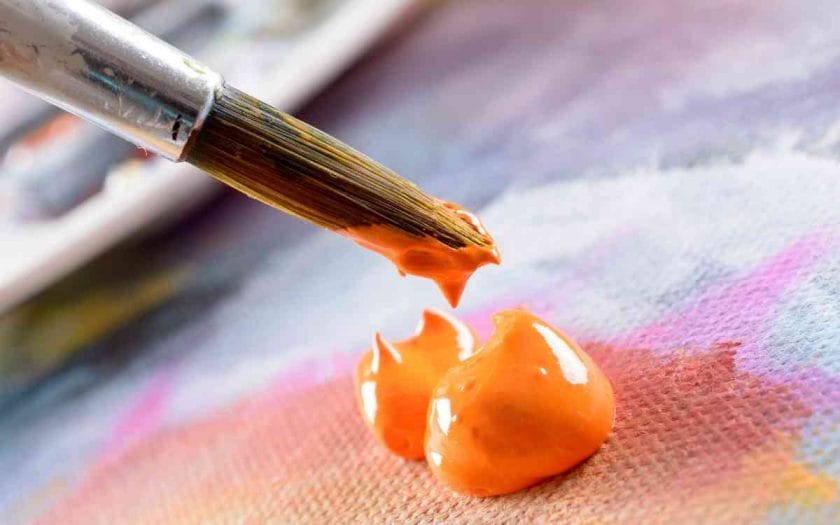When it comes to painting, there are a lot of different mediums to choose from. Some people prefer to use acrylic paint, while others might prefer oils or watercolors. But what about metal?
Can you use acrylic paint on metal? In this blog post, we will explore the answer to that question and give you some tips on how to get the best results!

Can You Use Acrylic Paint on Metal?
Yes, you can use acrylic paint on metal. Acrylic paint is one of the most versatile and widely used types of paint.
Known for its ability to adhere to a variety of surfaces, it’s no wonder that so many people turn to acrylics when they’re looking for a reliable and durable option. Here’s why acrylics are perfect for painting metal surfaces.
Adhesion
One of the most important properties of any paint is its ability to adhere or bond to the surface on which it is applied.
This is especially important when painting metal, as metal can be notoriously difficult to get paint to stick to.
However, acrylic paints have excellent adhesion properties thanks to their chemical makeup. The binder in acrylic paint is an acrylic resin, which forms a film when the paint dries on the metal surface.
This film helps the dried paint resist water damage, fading from sunlight, and chipping or flaking when scraped or scratched. So, acrylic will paint will stick to metal and remain intact for long period.
Versatility
Another reason acrylics are a great choice for painting metal surfaces is their versatility. Acrylics can be used on a variety of different metals, including aluminum, brass, and copper.
They can also be used on metal objects with intricate designs or difficult-to-reach areas—something that can’t always be said of other types of paint.
Acrylics are also available in a wide range of colors, so you’re sure to find the perfect shade for your project.

Quick Dryness
Acrylic paint dries fast. This quality can be beneficial if you work on a tight-deadline project. Additionally, because acrylic paint dries quickly, you won’t have to worry about your paint job taking days or weeks to dry.
You can usually expect your acrylic paint to dry in about 15 minutes. This quick-drying time means that you can apply a second coat of paint sooner, which can speed up the overall painting process.
Easy Clean-Up
Another advantage of using acrylic paint on metal surfaces is that it is easy to clean up. This means you won’t have to spend hours trying to remove dried paint from your brushes and other equipment.
Most importantly, if you make a mistake while painting, you can easily fix it without having to start your project from scratch.
Cost-Effectiveness
In addition to being versatile and durable, acrylics are also budget-friendly. Thanks to their affordability, you can experiment with different colors and finishes without breaking the bank—something that’s not always possible with more expensive types of paint.
Plus, since acrylics dry quickly and don’t require any special equipment or training to use, you’ll save time and money on your project overall.
How to Use Acrylic Paint on Metal
Now that we know that acrylic paint will stick to metal surfaces, let’s go over how to use it.
Step 1: Choose the Right Paint
Not all acrylic paints are created equal. You will want to use an acrylic paint that is specifically designed for use on metal. These paints are typically labeled “acrylic enamel” or “acrylic urethane.”
Acrylic urethane paints are some of the most durable and long-lasting paints available on the market. They are specifically designed to withstand the elements and resist fading, chipping, and peeling.

On the other hand, acrylic enamel paints have a high gloss finish that will give your metal surface a rich, professional look.
While acrylic enamel paints share many benefits as acrylic urethane paints, they are not as resistant to fading and chipping.
However, they are typically less expensive than their urethane counterparts, making them a good choice for those on a budget.
Whichever type of paint you choose, be sure to follow the manufacturer’s instructions carefully to ensure the best results.
If you are new to painting metal, you may want to start with acrylic enamel paint, which is easier to use and dries to a softer finish. Once you have chosen the right paint, you are ready to begin painting!
Step 2: Prepare the Surface
Before you start painting, you need to make sure that the surface you are painting is clean and free of any debris.
If the surface is not clean, the paint will not adhere properly and your paint job will not be as durable. To clean the surface, simply wipe it down with a rag soaked in rubbing alcohol.
Once the surface is clean, you need to sand it down to create a smooth base for the paint.
If the surface is not sanded, the paint will not adhere properly and your paint job will not be as smooth.
To sand the surface, simply use a piece of fine-grit sandpaper and lightly sand the entire surface.
Once you have sanded the surface, you are ready to start painting! Before that, clean the surface once again.
Step 3: Prime the Surface
Once the surface is clean, you need to prime it. This step is important because it provides a smooth base for the paint to adhere to and also helps to prevent rusting.
To prime the surface, simply apply a thin layer of primer with a brush or roller and allow it to dry completely before proceeding to the next step.
Once the primer is dry (according to the manufacturer’s instructions), you can begin painting with your chosen color of acrylic paint.
Step 4: Apply the Paint
Now it’s time to apply the paint! To do this, simply dip your brush or roller into the paint and apply it to the surface in even strokes.
Use long brushstrokes in a single direction so that there are no visible brushstrokes in the final product.
Be sure to work in small sections so that the paint does not have a chance to dry before you can spread it evenly.
Allow the first coat of paint to dry completely before adding additional coats until you achieve your desired level of opacity.
It typically requires two to three coats of paint for full coverage.
Once you have achieved your desired level of opacity, allow the paint to dry completely before doing anything with the painted surface.
How to Seal Acrylic Paint on Metal Surfaces After Painting
After the paint has dried completely, you need to apply a clear coat. This step is important because it helps protect your paint job from scratches, chipping, and fading. We’ll educate you on how to perfectly seal acrylic paint on a metal surface.
Step 1: Gather Your Supplies
Before you begin, ensure you have all the supplies you’ll need:
- a can of clear acrylic sealer,
- a paintbrush, and
- a piece of cardstock or poster board.
Step 2: Prepare the Area
Whether you’re working inside or out, it’s important to prepare the area before you start sealing. If you’re working outside, use painter’s tape and newspapers or drop cloths to protect the area around your work surface from overspray.
If you’re working inside, ensure the room is well-ventilated by opening windows and doors. You might also want to consider wearing a dust mask to avoid inhaling fumes.
Step 3: Choosing the right Sealer
There are two main types of acrylic sealers: glossy and matte.
Glossy sealers will give your piece a shiny finish, while matte sealers will give it a more muted look.
You can also find sealers that are specifically designed for use on metal surfaces. These sealers will help to prevent corrosion and rust.
Step 4: Apply the First Coat of Sealer
Once you’ve decided on the right sealer, it’s time to apply it to your piece. If you’re using a spray can, hold it about 6-8 inches away from the surface and apply even sweeping strokes.
If you’re using a paintbrush, dip it into the sealer and then apply it to the surface in long, even strokes.
Make sure to cover the entire surface, including any areas that might have been missed during the painting process.
Once you’ve finished applying the first coat of sealer, set your piece aside and allow it to dry completely. This usually takes about an hour.
Step 5: Apply a Second Coat of Sealer
Once the first coat of sealer has dried completely, it’s time to apply a second coat. This step is important because it will help to ensure that your paint job is properly protected.
Once again, hold the spray can about 6-8 inches away from the surface and apply even sweeping strokes.
Or, if you’re using a paintbrush, dip it into the sealer and then apply it to the surface in long, even strokes.
Once you’ve finished applying the second coat of sealer, set your piece aside and allow it to dry completely. Allow it to dry for 24 hours before using or displaying your work.
Conclusion
When it comes to painting metal surfaces, acrylic paint is a great option. Thanks to its adhesion properties, versatility, and quick-drying time, it’s easy to see why so many people turn to acrylics for their projects.
Plus, with so many colors to choose from, you’re sure to find the perfect shade for your next project.
So, don’t be afraid to experiment with acrylics the next time you’re looking to paint metal!
Have you ever used acrylic paint on metal? What tips would you add? Let us know in the comments below!
